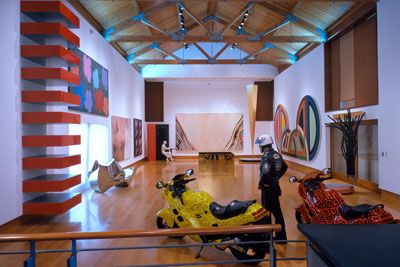
Photo courtesy Brian Forrest
NICOLE KLIEST
Staff Writer
Art is meant to be seen, and Frederick R. Weisman was a firm believer of this truth. Along with his wife Billie Miliam Weisman, Frederick Weisman also believed that people should be exposed to expressionist works.
“When you are so fortunate to be able to collect so much it’s not yours, it’s part of the world and you have to share it,” Billie Weisman said. She wore brown leggings trimmed with lace, a radiant turquoise tunic and deep chocolate-colored heels — surely, this was none other than the widow of the avant-gardist, Frederick R. Weisman.
The Frederick R. Weisman Foundation is comprised of more than 1,100 works of art, which were collected by Weisman starting in the mid-1950s. He collected most of the pieces during the 1980s with Billie.
Built in the 1920s, Weisman’s Mediterranean style, two story estate located in Los Angeles covers about 12,000 square feet, including a sculpture garden and an extension named “the annex,” built in 1991, which was designed by Franklin Israel to accommodate larger works of art. Approximately 400 works are on display at the estate, and the entire property is showered with lush greens and flowers, exuding an aura of freshness and serenity.
The estate is unique in that it does not give the vibe of a museum, but rather of a home. It makes individuals feel like they are part of an experience, rather than just viewing art.
The director of Pepperdine’s Frederick R. Weisman Museum and Art History Professor, Michael Zakian, said he considers the Weisman Art Foundation’s collection, housed in Weisman’s former home, to be one of the great unsung cultural treasures in Los Angeles.
“Mr. Weisman wanted to present the public with a model of how an individual can live everyday with great works of art, so the furniture is how it was when he was alive,” Zakian said. “Amazing examples of works by modern masters fill every corner.”
Zakian added that during a period in his career he visited the collection almost every month.
“On each visit I noticed treasures that I had previously overlooked,” he said.
Pieces at the Weisman estate range from artists such as Picasso, Joe Goode, Max Ernst, Andy Warhol, Cezanne, Rothko and numerous others, particularly from the Los Angeles area. The types of art also range from works by European modernists, surrealists, and abstract expressionists and include color-field paintings, pop art, postwar art and contemporary California works.
Visitors walking through the estate will find a surprise around every corner — a cast from a live motorcyclist, flashing neon signs, surrealistic paintings, a huge donkey sculpture, a bathroom with never ending mirrors, a classic Rolls-Royce and many different types of contemporary art.
“A lot of people become frightened by contemporary art, but when they see it in a home environment, they somehow can relate to it more,” Billie Weisman said. “With our exhibitions, we like to keep that theme.”
Some significant pieces at the museum include “Mother and Child” by Picasso, a portrait of Frederick Weisman by Andy Warhol and a Jackson Pollock from 1948.
As amazing as the entire estate and its works are, knowing the background of Frederick Weisman enhances the experience.“Frederick was an adventurous collector who relied on his own judgment rather than the expert opinions and critical tendencies of the time,” Billie said in her foreword for the museum’s catalog, “The Eclectic Eye,” which features many of her husband’s collected pieces.
Frederick Weisman, in addition to being a collector, was also a philanthropist and successful businessman. He purchased Mid-Atlantic Toyota in 1970 which was the first Toyota distributorship in the United States.
Frederick Weisman’s vision for art and philanthropic work has been strongly maintained. Billie Weisman said her husband used to say that “art goes on, life goes on, and we have to change with the times. You can’t sit still, especially not in business or in art.”
Students interested in taking a private tour of the estate must make a reservation by calling the Weisman Foundation at (310) 277-5321.
10-04-2007

